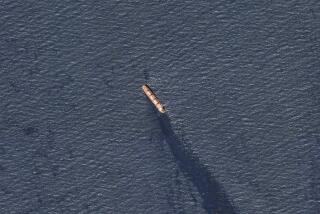Chernobyl Disaster Provides Rare Chance : Fallout Aids Science in the Black Sea
- Share via
NEW YORK — Radioactive fallout from the disaster at Chernobyl has provided an unexpected benefit for science--the opportunity to uncover the mysteries of the Black Sea.
An international team of oceanographers is tracking the radioactive fallout from Chernobyl as it settles into the marine system of the unusual 180,000-square-mile body of water, sandwiched between Turkey, Bulgaria, Romania and the Soviet Union.
“The Black Sea is unique and very little is known about it,” said Kenneth O. Buesseler, a chemist at the Woods Hole Oceanographic Institution in Massachusetts who is part of the study. “Perhaps this is because of the politics of the countries, but it has not been studied extensively.”
Extremely Stagnant
The Black Sea, almost totally enclosed save a narrow channel to the Mediterranean, has no tides and is extremely stagnant, according to scientists.
Its surface waters are filled with oxygen and alive with fish. But the water below 300 yards is devoid of both oxygen and life. And its bottom, 7,000 feet below the surface, is layered with toxic sediment.
“You see a number of fresh-water lakes like this, such as Cameroon,” said Buesseler, referring to the African lake that emitted a deadly cloud of toxic gas last year. “The Black Sea is the largest body of water with this (condition).”
Buesseler said the Black Sea is like the oil and vinegar of a salad dressing. Fresh water from a myriad of rivers has made the top waters light and filled with oxygen, allowing the heavy saltier water to sink to the bottom where it remains undisturbed.
In June of last year, scientists from the institute joined scientists from Turkey and West Germany to measure fallout in the Black Sea from the nuclear accident that occurred at the Chernobyl power plant complex in the Soviet Union a few months earlier.
Buesseler said radioactive isotopes from the fallout, which also landed in rivers feeding the Black Sea, act like markers indicating water flow and chemical processes within the marine system.
Scientists have used radioactive fallout to study oceans before. The nuclear weapons tests in the 1960s and 1970s provided significant information about the workings of the Pacific Ocean, Buesseler said in a telephone interview.
He said results from the Black Sea study are still preliminary, but it appears there is little mix between the top oxygen-rich waters and the heavier, oxygen-deprived waters below.
“There is a clear line between the two,” he said.
The scientists also found that heavy trace metals from the fallout sank quickly from the top waters to the bottom of the sea. A sample of sediment showed trace metals had fallen to the bottom within months of the accident.
But it appears that highly soluble elements from the fallout, such as cesium-137, will take longer to disappear from the water, perhaps over 100 years, Buesseler said.
He said levels of cesium-137 in the top water of the Black Sea are 10,000 times greater than what is considered safe for drinking water.






